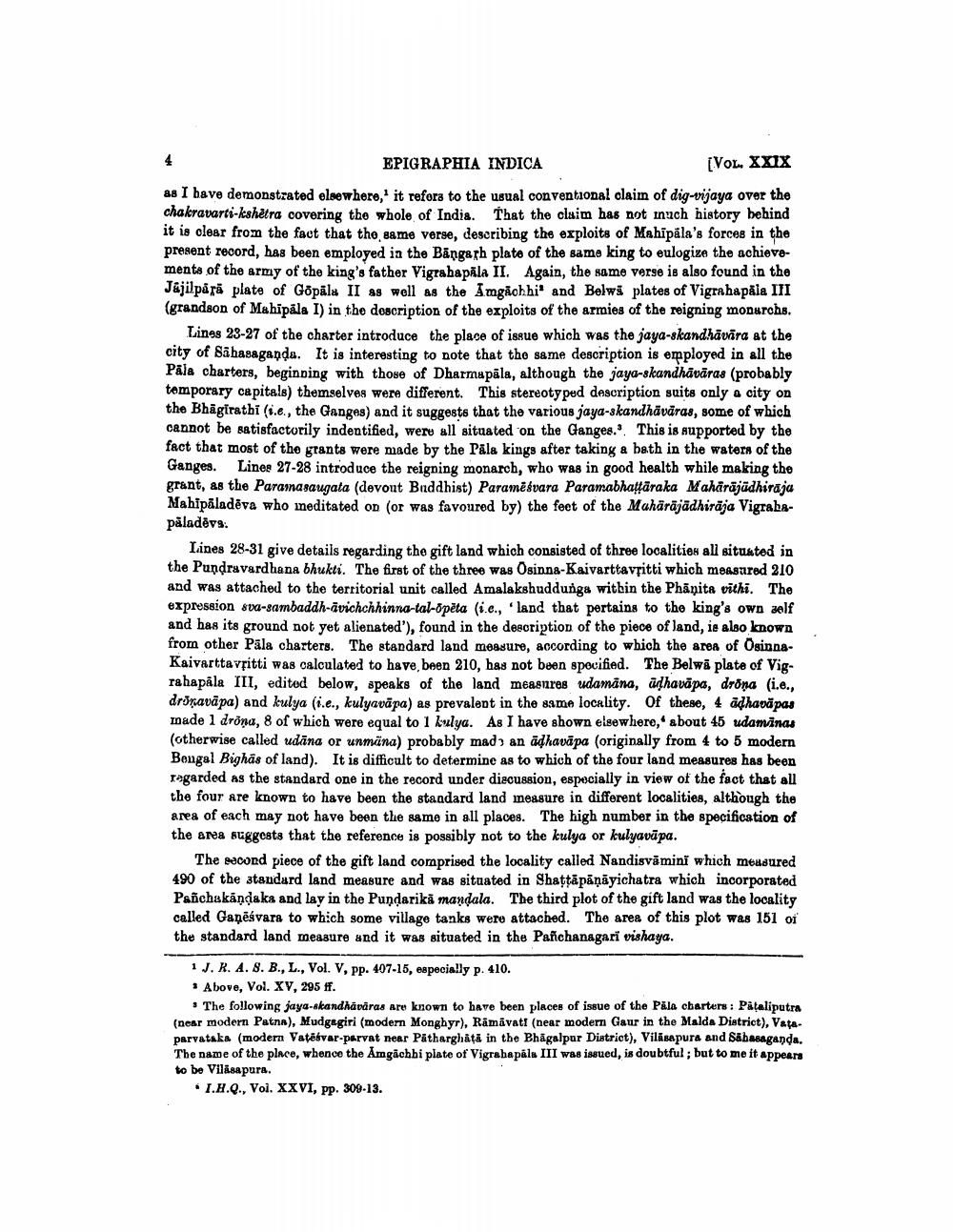________________
EPIGRAPHIA INDICA
[VOL. XXIX
as I have demonstrated elsewhere, it refors to the usual conventional claim of dig-vijaya over the chakravarti-kshetra covering the whole of India. That the claim has not inach history behind it is clear from the fact that the same verse, describing the exploits of Mahīpala's forces in the present record, has been employed in the Bāngath plate of the same king to eulogize the achievements of the army of the king's father Vigrahapala II. Again, the same verse is also found in the Jājilpără plate of Gopāla II as well as the Imgāchhi' and Belws plates of Vigrahapala III (grandson of Mahipāla I) in the description of the exploits of the armies of the reigning monarchs.
Lines 23-27 of the charter introduce the place of issue which was the jaya-skandhāvāra at the city of Sabasaganda. It is interesting to note that the same description is employed in all the Pāla charters, beginning with those of Dharmapala, although the jaya-skandhāvāras (probably temporary capitals) themselves were different. This stereotyped description suits only a city on the Bhagirathi (i.e., the Ganges) and it suggests that the various jaya-skandhävaras, some of which cannot be satisfactorily indentified, were all situated on the Ganges. This is supported by the fact that most of the grants were made by the Pāla kings after taking a bath in the waters of the Ganges. Linee 27-28 introduce the reigning monarch, who was in good health while making the grant, as the Parainasaunata (devout Buddhist) Paramësvara Paramabhattāraka Mahäräjūdhiraja Mahipăladēva who ineditated on (or was favoured by) the feet of the Maharajadhirāja Vigrahapăladēvs.
Lines 28-31 give details regarding the gift land which consisted of three localities all situated in the Pundravardhana bhukti. The first of the three was Osinna-Kaivarttavfitti which measured 210 and was attached to the territorial unit called Amalakshuddunga within the Phānita vithi. The expression sva-sambaddh-āvichchhinna tal-opeta (i.e., 'land that pertains to the king's own self and has its ground not yet alienated'), found in the description of the piece of land, ie also known from other Pāla charters. The standard land measure, according to which the area of OsinnaKaivarttavritti was calculated to have been 210, has not been spocified. The Belwā plate of Vigrahapala III, edited below, speaks of the land measures udamana, adhavāpa, dröna (i.e., dronavāpa) and kulya (i.e., kulyavāpa) as prevalent in the same locality. Of these, 4 adhavapas made 1 drõna, 8 of which were equal to 1 kulya. As I have shown elsewhere, about 45 udaminas (otherwise called udāna or unmäna) probably mad) an adhavāpa (originally from 4 to 5 modern Bengal Bighas of land). It is difficult to determine as to which of the four land measures has been ragarded as the standard one in the record under discussion, especially in view of the fact that all the four are known to have been the standard land measure in different localities, although the area of each may not have been the same in all places. The high number in the specification of the ana suggests that the reference is possibly not to the kulya or kulyavāpa.
The second piece of the gift land coraprised the locality called Nandisvā mini which measured 490 of the standard land measure and was situated in Shattāpāņāyichatra which incorporated Panchukāndaka and lay in the Pundarikā mandala. The third plot of the gift land was the locality called Gaņēsvara to which some village tanks were attached. The area of this plot was 151 of the standard land measure and it was situated in the Panchanagari vishaya.
1 J. R. A. 8. B., L., Vol. V, pp. 407-15, especially p. 410. * Above, Vol. XV, 295 ff.
• The following jaya-skandhävaras are known to have been places of issue of the Pala cbarters: Pataliputra (near modern Patna), Mudgagiri (modern Monghyr), Rāmīvati (near modern Gaur in the Malda District), Vataparvataka (modern Vatēsvar-pervat near Patharghată in the Bhagalpur District), Vilābapura and Sabasaganda. The name of the place, whence the Amgachhi plate of Vigrahapala III was issued, is doubtful; but to me it appears to be Vilasapura.
• I.H.Q., Vol. XXVI, pp. 309-13.




